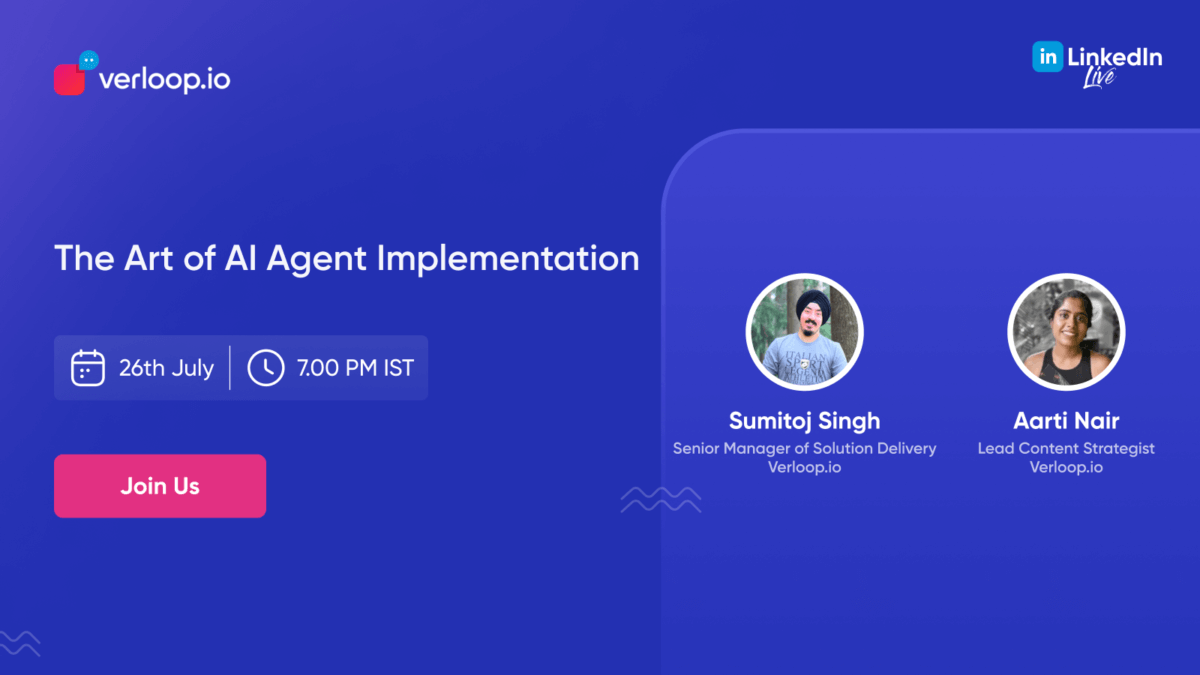

Hosted By

Aarti Nair
Lead Content Strategist, Verloop.io
Panellists
Ready to revolutionise your customer support with AI agents? Master the art of AI agent implementation with our expert, Sumitoj Singh, Senior Manager of Solution Delivery at Verloop.io.
On July 26th at 7 PM, we hosted an exclusive LinkedIn Live webinar, “The Art of AI Agent Implementation: Avoiding Common Pitfalls.” Missed it? No worries! Here’s your chance to catch up on the game-changing insights and actionable strategies shared during the session.
Want the full webinar experience? Request the webinar recording now and take the first step towards seamless AI agent implementation!
Webinar Transcript:
Introduction
-
Aarti – Hey everyone!
Remember the early days of rule-based chatbots? They were great at handling straightforward queries but often hit a wall with more complex ones. Well, we’ve come a long way! Now, we’ve got AI agents that can tackle complex questions in real-time, making conversations smoother, more human-like, and incredibly helpful—90% of the time when implemented correctly!
I’m Aarti, and joining me is Sumitoj, our Senior Manager of Solution Delivery here at Verloop.io.
- Sumitoj – Hi Aarti! Hi everyone!
-
Aarti – Hi Sumitoj! Today, we’ll explore “The Art of AI Agent Implementation: Avoiding Common Pitfalls.” Sumitoj, with his extensive experience in deploying AI solutions, will share insights and tips on how to make the most out of these powerful tools. So grab your coffee, settle in, and let’s get started!
So before we get started – Sumitoj, would you like to tell us a bit about yourself and your role here at Verloop.io?
-
Sumitoj – Sure Aarti . Thanks for having me! I’m thrilled to be here today to talk about AI Agents. As the Solution Delivery Manager at Verloop.io, I oversee all our implementation projects. This topic is especially exciting for me because it directly impacts a company’s ROI when done right.
I’ve been in the IT industry for about 12 years, and I’ve always been fascinated by the potential of AI in our daily lives. Landing at Verloop was a perfect fit and it’s been amazing to work with NLP, Gen AI implementations, and product improvements over the last year. This experience has completely transformed my perspective on customer support and the power of AI to enhance the customer experience.
- Aarti – Thanks, Sumitoj! Your dedication to client success is truly inspiring. I’m sure the audience are excited to hear your insights today. So, are we ready to dive in?
- Sumitoj – Absolutely Aarti , let’s get down to business!
Importance of AI Agent Implementation
Why AI Agents Matter
- Aarti – Perfect! Let’s jump right in. Sumitoj, can you please talk a little bit about why AI Agents have become so crucial in today’s customer support landscape?
-
Sumitoj – Sure thing. AI agents, powered by Large Language Models, are revolutionising customer support by offering a new level of personalised interaction. Unlike traditional chatbots with pre-programmed responses, AI agents can understand the nuances of human language and respond in a way that feels natural and conversational.
AI agents bring several key benefits that are completely transforming the way customer support works.
First up, there’s the 24/7 availability – In today’s always-on world, customers expect answers now, not later. Traditional support often means long wait times or limited hours. AI agents fix that by being available around the clock, 365 days a year. This means customers can now get the information or assistance they need anytime, anywhere, regardless of time zone or agent availability. This is a major win for customer satisfaction!
And this also translates to reduced wait times. That’s again another key benefit. AI Agents can handle simple queries quickly and efficiently, such as answering FAQs or providing basic troubleshooting steps. This frees up human agents to focus on more complex issues that require a personal touch or empathy.
And let’s not forget the cost savings aspect. By automating repetitive tasks, AI Agents can significantly reduce operational costs for businesses. Imagine the number of calls your support team fields daily for basic questions about return policies or order tracking. AI Agents can handle these inquiries efficiently, taking the pressure off your human resources and potentially lowering overall support costs.
- Aarti – Those are fantastic points, Sumitoj. But it’s important to remember that these benefits only come with effective implementation, right?
- Sumitoj – Yes absolutely. Because a poorly designed or implemented AI Agent can create a frustrating experience for users and ultimately damage your brand reputation. Without a strategic approach, AI Agents can cause more frustration than they resolve.
Common Goals for AI Implementation
- Aarti – Hmm. So speaking of implementation, what are some key goals businesses should shoot for when bringing on an AI Agent?
-
Sumitoj – Great question! The first step actually involves taking a step back to understand the core business need that the AI Agent is meant to address. Are you looking to improve the overall customer experience across all touchpoints? Perhaps streamline the support function itself, or maybe there are other derivative goals like reducing response times, resolution times, or even support operation costs?
Once you have a clear understanding of the business need, you can then define specific goals for your AI Agent implementation. Here are three common goals businesses typically aim for:
First, enhancing customer experience. This means making sure the AI Agent helps people quickly and smoothly. Ideally, customers should find what they need with ease through their chatbot interaction. We can track this by seeing if their questions were covered by the AI’s knowledge base or if the troubleshooting steps were clear.
The second goal – streamlining those support operations. By automating repetitive tasks like answering FAQs or providing basic troubleshooting steps, AI Agents can free up human agents for the trickier issues that need their expertise and human touch. This can lead to a more efficient support team overall.
The third goal is reducing response times. This ties back to the 24/7 availability we discussed earlier. By training AI Agents with the right information to handle user requests, they can answer customer queries promptly, often within seconds for the simple stuff. A native bot if architectured properly with the correct set of choices, can help cater to user queries within seconds. And this can seriously boost customer satisfaction.
Challenges in AI Agent Implementation
- Aarti – That makes so much sense Sumitoj. To understand implementation a little more in detail, let’s talk about common pitfalls. So what are some of the main challenges you’ve seen businesses face during AI Agent implementation?
-
Sumitoj – Well, There are several common pitfalls that can derail an AI Agent project. I’ll talk about a few common ones to watch out for.
The first, and maybe most important, is the “launch now, plan later” pitfall, the lack of clear objectives. Businesses sometimes jump into the implementation without clearly defining their goals. They know they want to improve customer support, but they lack a specific roadmap for how the AI Agent will achieve that. For instance, imagine a customer contacts the AI Agent about a product they haven’t received. Now the AI Agent should be able to create a support ticket for this issue, but without clear objectives, the process for how and where this ticket is created might be unclear. This frustrates the customer and hinders the AI Agent’s effectiveness.
Another challenge is technical expertise. AI Agent implementation often involves integrating the chatbot with existing systems. This can be complex and requires a certain level of technical know-how about the product or service being integrated. For example, understanding the nuances of how different systems interact is crucial for a smooth integration.
And we can’t forget about the user experience. Neglecting user experience is a major pitfall. It’s important to design the chatbot interaction with the user in mind. This means thinking through the best course of action for critical use cases. For instance, if a customer had a conversation with a human agent that needs to be continued, the AI Agent should ideally allow them to reconnect with the same agent (“it is called the sticky agent”) rather than forcing them to explain the issue all over again to a new agent.
And finally, ignoring continuous improvement is a missed opportunity. AI Agents are excellent tools for gathering information about common customer problems. However, it’s essential to regularly analyse this data and use it to improve the AI Agent’s training. This allows the chatbot to adapt to new scenarios and user queries over time. Unfortunately, many businesses fail to take advantage of this valuable data.
- Aarti – Wow! That’s so insightful, Sumitoj. So it’s not just about building the chatbot, but also making sure it works smoothly with other systems and has a clear purpose in mind.
- Sumitoj – Exactly
Best Practices
- Aarti – That’s fantastic advice, Sumitoj. Now that we’ve unpacked the challenges, any recommendations on best practices to avoid these pitfalls?
- Sumitoj – Sure! Why not.
So, as we discussed, Setting Clear Objectives is the foundation for any chatbot project. First things first, define exactly what you want your chatbot to achieve and how it aligns with your overall customer support strategy. Is it to answer FAQs, troubleshoot basic issues, or qualify leads? Having clear objectives will guide the development process and ensure the chatbot is designed to meet specific needs.
- Aarti – That makes a lot of sense. We need to know the problem we’re trying to solve with the chatbot.
- Sumitoj – Exactly! Let’s take an example. Imagine you want to implement an AI Agent to help users purchase insurance. A clear objective might be to start by qualifying the user’s needs with a series of questions about existing coverage and desired protection. Then, the AI agent can guide the user through the purchase process.
- Aarti – I see. So, the AI Agent should walk the user through a specific journey?.
- Sumitoj – Right. Once you have clear objectives, you can move on to other best practices. Let’s talk about technical expertise. It’s important to be open to new ideas and approaches during implementation. Additionally, having the necessary groundwork laid out can streamline the process. This might include things like API documentation and data required for training the chatbot. Depending on your goals, you could also consider integrations with tools like Google Sheets for data collection, support ticket creation systems, or CRM platforms for data transfer.
Next, focus on the user experience. This is critical for implementation success. You need to understand the most important pain points of your users and make sure the chatbot addresses them effectively as part of the user journey. A great example of this is chat banking, where the chatbot can handle many everyday banking tasks, making the process faster and easier for users.
Finally, we need to discuss continuous monitoring and optimisation. Chatbots are not set-it-and-forget-it tools. As a company, you should analyse historical data to understand which processes need improvement and identify areas where new features could enhance the user experience. This data is a goldmine for optimizing your chatbot and ensuring it stays effective over time.
Conclusion and Recap
- Aarti – That’s fantastic advice, Sumitoj! Thanks so much for sharing your expertise with us today. I think this pretty much wraps up our webinar.
It’s been a goldmine of information, Sumitoj! I learnt a lot and I’m sure the audience has learned a lot about how to successfully implement AI Agents and avoid some of the common pitfalls too.
So, any last words of wisdom for the audience before we sign off?
-
Sumitoj – Absolutely, Aarti Thanks for having me, it was a blast talking about AI Agent implementation with you and everyone here.
And yes, Just a quick recap from my end. Remember, there are just a few key ingredients for successful chatbot implementation:
First up and most important, crystal clear objectives. Make sure you know exactly what you want your AI Agent to do and how it fits into your overall customer support strategy.
Two, Proper Training. Feed your solution high-quality training data to ensure it can understand user intent and respond accurately.
Thirdly, User-Centric Design is key. Focus on creating a user-friendly experience with clear, concise language, and the ability to handle multiple conversational turns.
Last but not least, continuous improvement. Like I said earlier Chatbots are not “set-it and forget-it” tools. Don’t let your AI Agent become stagnant. Monitor user interactions, analyse data, and keep refining your chatbot regularly to optimise performance and meet evolving customer needs.
- Aarti – Those are fantastic takeaways, Sumitoj. Thanks once again for your time and expertise. For the audience, We hope you enjoyed our today’s session! And if you have any questions please feel free to ask them in the comments section and we’ll be more than happy to answer them.
- Sumitoj – Absolutely, we’re happy to answer any questions. Thanks Aarti. And Thanks everyone for joining us today.
- Aarti – Thanks everyone, Have a great day!



